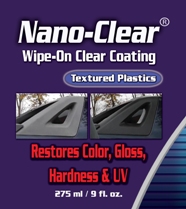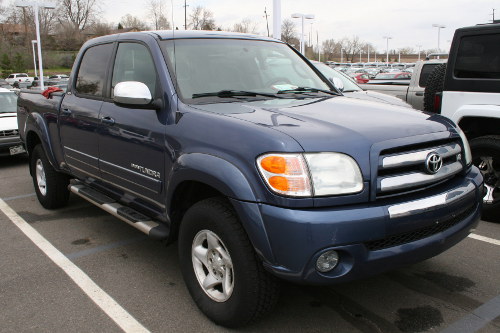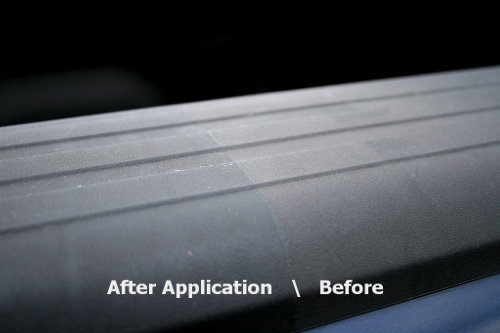Nano-Clear Coating Review – The Science is Cool, But The Results Are Underwhelming
Jason Lancaster | Jun 18, 2013 | Comments 9

Nano-Clear Review
I’m a science nerd, so when I read about Nano-Clear – a new coating that promises to restore the original luster of plastic parts, protect painted surfaces, reduce aerodynamic drag, and even “self heal” minor scratches, I was excited. So excited I didn’t hesitate to order a small bottle of the stuff from the Nanovere Technologies website. that is supposed to restore textured plastics, i.e. the often faded black plastic used for truck mirrors, bed rails, etc.
When my small bottle of Nano-Clear coating arrived, I couldn’t wait to put it to the test. While I’m still a huge fan of the idea behind Nano-Clear, my simple review of the product was underwhelming.
What Is Nano-Clear and Why Should I Care?
Basically, Nano-Clear is a specific type of nano coating designed for textured plastics, which are often the black plastic used for bed rails, bumper covers, and side mirror housings (at least on trucks). These textured plastics are particularly vulnerable to oxidation and UV fading, so there are quite a few products designed to restore these parts to their original luster (like Mothers “Back to Black” and Turtle Wax “Trim Shine,” to name a couple).
What makes Nano-Clear unique is the nano-sized structure of the polymer: the molecules in Nano-Clear are quite a bit smaller than the molecules found in most coatings. Because the molecules are so tiny:
- They repel water and almost all contaminants, which means the product is self-cleaning.
- They become ever-so-slightly “liquid” when exposed to UV. This means that any scratches in the coating will “heal” themselves in sunlight.
- Adhesion is strong, meaning that the coating will last a long, long time after initial application (Nanovere says at least 10 years).
Considering the self-cleaning and self-healing properties and the 10 year warranty, and considering products like “Back to Black” need to be re-applied every few weeks, the appeal of Nano-Clear should be obvious…just apply it once to your black plastic parts and never worry about it again.
The Test – A Plastic Bed Rail on A Gen1 Tundra
I found a “donor” vehicle that seemed like a good test subject – a blue 06′ Tundra with some slightly faded ABS bed rails. While the bed rails weren’t extremely faded, they weren’t black and shiny either. While not an ideal candidate (Nano-Clear is best on “highly oxidized” plastics), it was close at hand.

Our Nano-Clear Test Vehicle – a Blue 2006 Tundra
First, following directions, I bathed the bed rail in rubbing alcohol and wiped it down carefully with a lint-free towel.
Next, I grabbed my “Nano-Clear® for Textured Plastics” sample kit, ripped it open, and removed the contents…where I ran into disappointment #1: The kit is supposed to come with a special “3M folded applicator,” but what it really came with was a blue paper towel that left lint behind during application as it started to break down. Lame.
Opening the bottle of goop was difficult, as the cap seemed to be sticking a bit – almost like the bottle had leaked. Once I got the cap off, I instantly recognized a toxic smell from my youth: modeling glue (I used to make car and airplane models as a kid…not very well either). It was a powerful stink that all but necessitates outdoor application, not to mention that the goop is bad for bare skin. You must wear gloves during application, as the material will stick to your fingers like super-glue.
After carefully applying the coating to the bed rail, I waited about 30 minutes to see the difference. As you can see from the photo below, that was disappointment number 2: not very shiny, nothing to write home about.
What Went Wrong?
I’m not sure that anything actually “went wrong” with this coating – it just didn’t meet the expectations that Nanovere set in their own how-to video below.

The video shows an almost dramatic improvement in gloss and shine, and that’s not what I noticed. Not even a little bit.
Of course, gloss and shine isn’t all that Nanovere is selling. In addition to restoring shine and gloss, Nanovere says their product:
provides oustanding scratch, chemical, and UV resistance as well as self-cleaning properties including water, oil, ice, and brake-dust repellency
My quick application (which looked the same after 2 days) wasn’t exactly shiny, but my two days of “testing” was hardly adequate when it came to addressing the other properties. If this shine was maintained for the next 10 years, that would be something to write home about.
Still, this stuff is pricey. $49.95 + $9 for shipping for a 9 oz. bottle of Nano-Clear vs. $7 for an 8 oz. bottle of “Back to Black.” If you can use an 8oz bottle of Back to Black to shine up your bed rails, bumper, and mirrors 3-5 times before it runs out, it would take a while for you to spend enough on Back to Black (or similar) to make Nano-Clear cost effective (without considering application time, that is). Not to mention that you’ll need some additional application towels and rubbing alcohol to apply Nano-Clear.
The Bottom Line: The technology behind Nano-Clear seems awesome, but the shine and gloss is underwhelming. Considering the high price, the toxic nature of the material, and the tedious application process, it’s not for the casual owner.
As much as I wanted to believe in the awesome abilities of Nano-Clear, I have a hard time recommending it. Even if the shine and gloss on my test bed rail matched what I saw in the Nanovere video, it’s still toxic stuff with an uncertain long-term value. I think the best thing to do might be to wait for another company (like Mothers or Meguiars) to incorporate this nano technology into their own products (assuming that’s possible).
Thoughts?
Filed Under: Maintenance Tips



I agree Tim. Seeing is believing. I wouldn’t spend a dime on that product. I would rather Armor all everything. Boy that is desperate. Thanks Tim.
Mickey – This is actually one of my rare posts here on TundraHQ…I was excited to test this stuff myself and made time for it. 🙂
I’m with you – Armor All for $3 a bottle seems like a better option, despite the promises of a long-lasting coating that is self-cleaning. It’s just too expensive.
Jason,
We will be happy to provide you with a refund or new product to test. I would agree something went wrong.
Regards,
Tom Choate
Nanovere
Tom – No need for a refund – thanks for commenting.
Sorry Jason. I didn’t look at who did it. Just thought Tim did it. I don’t care to use Armor All but I would before this product.
Sorry to hear what happened but something definitly went wrong. I’m a painting contractor and it can happen. Variations in weather such as temperature, humidity, contamination of surface and many other things can be the cause. You may have the best product in the world in your hands but there are circumstances where things may go wrong…you just might have fell on one. I myself have not used the product but am looking into it so I am in no way affiliated with the company. Just my thoughts and my experience as a professional applicator of high end coatings.
I don’t know what happened when you applied it, but I did my step daughters car bumpers and running boards and it turned out beautiful, I used a round applicator, that you put tire shine on with. I cleaned the areas with thinner and let dry a good hour before applying the product. Wish I knew how to upload the pictures in here for you, all the sections I did look brand new.
This material can be used on metal also correct? I’m wondering how it does at scratch resisting from bushes, tree branches, etc… when offroading. If effective, that would be worth the product cost… Anyone have positive results in that regard?
With a skilled ultrasonographer, two gestational sacs,
two embryos and two distinct fetal heartbeats can be seen six weeks after the first day of the last menstrual
period. Additionally, your fat reserves are now being used up.
Fiber intake is extremely important, as is water intake and having regular bowel movements.